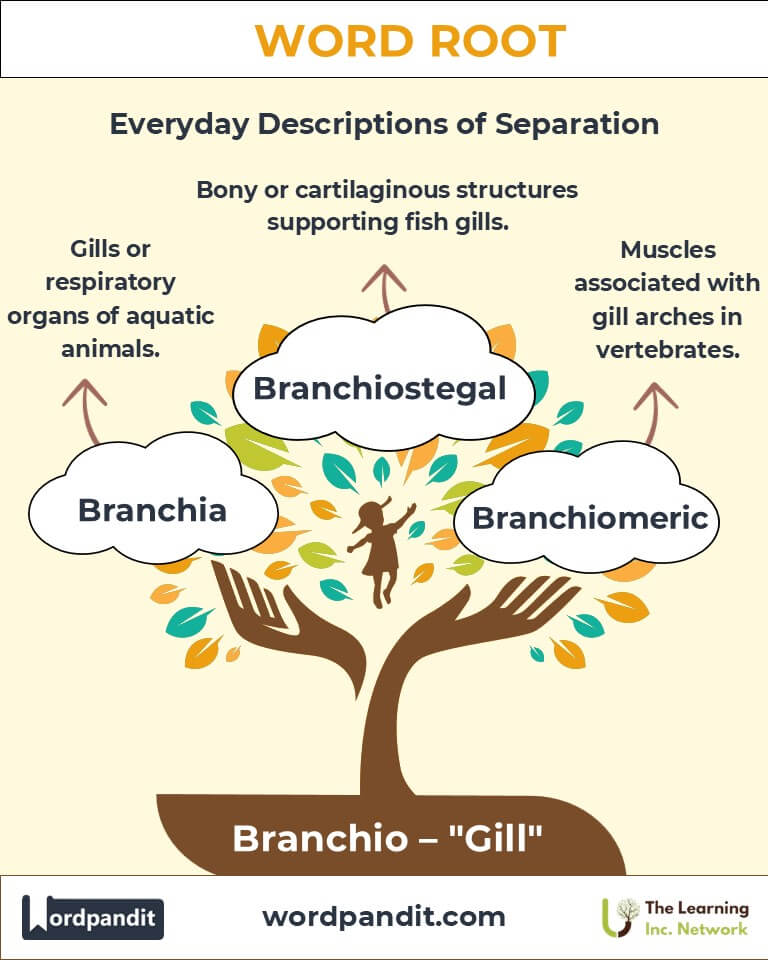Branchio: A Gateway to Aquatic Life and Evolution
Explore the fascinating world of "branchio," a word root derived from the Greek word for "gill." From its presence in terms like "branchia" (gills of fish) to "branchiopod" (a class of aquatic creatures), this root connects us to the aquatic realm, the lifeline of countless species and an essential part of Earth's evolutionary history.

1. Introduction: The Essence of Branchio
When we think of aquatic life, images of fish and their graceful movements often come to mind. Central to their survival are gills, the organs that allow them to extract oxygen from water. The root "branchio" (pronounced "bran-kee-oh") captures this essence, tracing its origin to the Greek word branchia, meaning "gills."
This root forms the basis of many terms related to marine biology and evolutionary studies, reminding us of life's adaptability in diverse environments.

2. Etymology and Historical Journey
The root "branchio" originates from ancient Greek, where branchia referred to the gills of fish and other aquatic creatures. Its usage spread as scientific study of marine biology evolved, making its way into taxonomy and anatomy. During the Renaissance, "branchio" became central to the naming conventions for aquatic organisms as scientists sought to classify life in greater detail.
3. Mnemonic: Unlocking the Power of Branchio
Visualize a school of fish breathing effortlessly underwater, their gills pulsing rhythmically. Now picture the word branchio written like bubbles rising from their gills.
“Branchio is the breath of the ocean, where gills bring life to water.”
4. Common Branchio-Related Terms
- Branchia: Gills or respiratory organs of aquatic animals.
Example: "The branchia of the fish were finely adapted for extracting oxygen from water." - Branchiopod: A class of small aquatic crustaceans, such as fairy shrimp.
Example: "Branchiopods play a vital role in freshwater ecosystems." - Branchiostegal: Relating to the bony or cartilaginous structures that support the gills in fish.
Example: "The branchiostegal rays help protect the gills of the fish." - Branchiomeric: Referring to the muscles associated with gill arches in vertebrates.
Example: "Branchiomeric muscles are key to the jaw movements of fish."
5. Branchio Through Time
- Branchiostoma (Lancelet): A primitive chordate with simple gill structures, bridging the gap between invertebrates and vertebrates.
Significance: Highlights the evolutionary transition from simple to complex respiratory systems. - Branchial Arches: Structures in embryonic development that evolve into gills in fish or jaw and ear structures in mammals.
Shift in Meaning: From aquatic respiration to terrestrial adaptations.
6. Branchio in Specialized Fields
- Marine Biology: Branchiopods are studied for their role in food chains and freshwater ecosystems.
- Anatomy: Branchial arches are critical to understanding vertebrate development.
- Evolutionary Biology: The study of branchiostomes helps unravel the evolutionary history of vertebrates.
7. Illustrative Story: Branchio in Action
Lila, a young marine biologist, was captivated by the tiny branchiopods she studied under her microscope. One day, she discovered that a local lake’s branchiopod population was declining, threatening the food web. By carefully analyzing water samples and implementing conservation measures, Lila ensured the branchiopods thrived once again. This experience underscored the profound importance of "branchio" in maintaining aquatic ecosystems.
8. Cultural Significance of Branchio
The root "branchio" symbolizes life’s connection to water. Ancient civilizations often revered fish for their ability to thrive in water—a realm humans could not inhabit. In modern times, "branchio" reminds us of the need to protect aquatic ecosystems, which are vital to global biodiversity and human survival.

9. The Branchio Family Tree
- Pisc- (Fish):
- Piscine: Relating to fish. Example: "The piscine world is incredibly diverse."
- Aqua- (Water):
- Aquatic: Living in or near water. Example: "Aquatic plants provide oxygen to marine life."
- Ichthy- (Fish):
- Ichthyology: The study of fish. Example: "Ichthyology contributes to our understanding of marine ecosystems."
10. FAQs About the Branchio Word Root
Q: What does "branchio" mean?
A: The root "branchio" comes from the Greek word branchia, meaning "gill." It refers to respiratory structures in aquatic organisms, such as the gills of fish.
Q: What are branchiopods?
A: Branchiopods are small aquatic crustaceans, such as fairy shrimp and water fleas. They play an essential role in freshwater ecosystems and belong to the class Branchiopoda.
Q: What are branchial arches?
A: Branchial arches are paired embryonic structures found in vertebrates. In fish, they develop into gills, while in mammals, they form parts of the jaw, ears, and throat.
Q: Why is "branchio" significant in biology?
A: The root "branchio" describes structures and processes linked to aquatic respiration. It also appears in terms related to evolutionary studies, connecting aquatic and terrestrial life forms.
Q: What role do branchiopods play in ecosystems?
A: Branchiopods are primary consumers in aquatic food chains, feeding on algae and microorganisms. They are also prey for larger organisms, contributing to the ecosystem’s balance.
11.Test Your Knowledge: Branchio Word Root Quiz
1. What does "branchio" mean?
2. What are branchiopods?
3. Branchial arches in humans develop into?
4. Which field studies branchial arches?
5. What is the function of branchiostegal rays in fish?

12. Conclusion: The Living Legacy of Branchio
The root "branchio" bridges the past and present, offering insights into the aquatic origins of life and the evolution of respiratory systems. From its biological significance to its cultural resonance, "branchio" continues to inspire discoveries and appreciation for life beneath the water’s surface. As we face environmental challenges, let "branchio" remind us of the interconnectedness of all living beings and the importance of conserving aquatic ecosystems.











